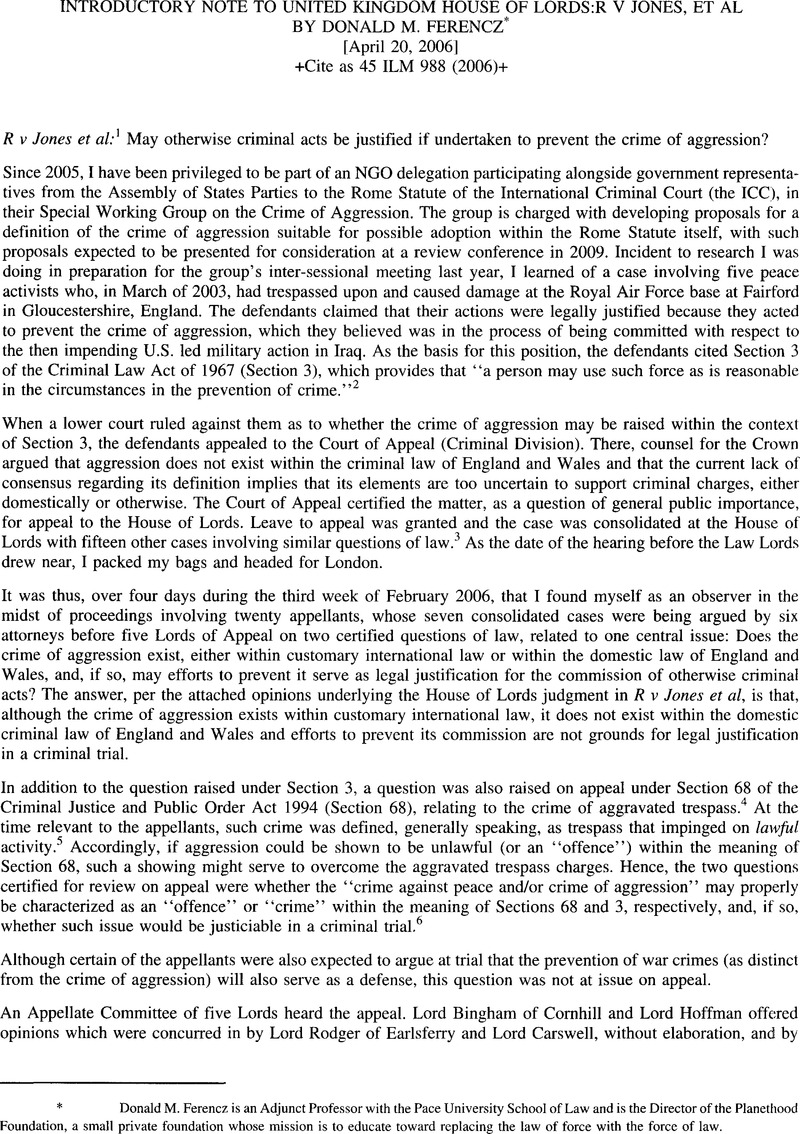Published online by Cambridge University Press: 18 May 2017

This text was reproduced and reformatted from the text appearing at the United Kingdom Parliament website (visited June 16, 2006) <http://www.publications.parliament.uk/>
1 R v Jones et al, Session 2005-2006, [2006] UKHL 16, on appeal from: [2004] EWCA Crim 1981 and [2005] EWHC 684 (Admin), Hearing dates: 20, 21,22 and 23 February 2006; Judgment rendered on 29 March 2006.
2 See id. at para. 24 for the precise language of Section 3.
3 The specific facts and case history relevant to the five appellants whose cases were originally conjoined are discussed within the judgment at paras. 3 and 4. Such appellants are referred to in the judgment as ‘ “The Fairford appellants.'’ The other cases on appeal related to fourteen activists who, as a group, trespassed at the Sea Mounting Centre, Marchwood Military Port, at Hythe in Hampshire (referred to in the opinion as “the Marchwood appellants“) and also to Valerie Swain, an activist who had entered the RAF base at Fairford in an action separate from those of the Fairford appellants and who had been convicted of aggravated trespass and criminal damage. At the time of the appeals, the Marchwood appellants and Valerie Swain had all already been convicted (with the imposition of fines and conditional discharges), while the Fairford appellants had not yet been tried.
4 See id. at para. 32 for the precise language of Section 68.
5 Ibid.
6 See id. at paras. 4 and 9.
7 It should be noted here that Lord Bingham of Cornhill observes that there has been no suggestion that “the crime against peace'’ and the ‘ ‘crime of aggression'’ are substantially different and that, therefore, as a matter of convenience, his opinion uses the term “aggression.” (See id. at para. 4, last sentence). With respect to his conclusion that the core crime of aggression exists with sufficient clarity so as to permit trial, see id. At para. 19.
8 Ibid.
9 See id. at paras. 11-18.
10 For Lord Bingham of Cornhill's analysis of the assimilation issue see id. at paras. 20-23.
11 See id. at para. 22, last sentence.
12 The cases cited are Nulyarimma v Thompson (1999) 120 ILR 353, and Sosa v Alvarez-Machain et al 542 US 692 (2004), respectively. (See id. at para. 23).
13 See id. at para. 29. On this issue, Lord Bingham of Cornhill earlier cites Sir Franklin Berman's Asserting Jurisdiction: International and European Legal Perspectives, ed M Evans and S Konstantinidis, 2003, p 11. (Id. at para. 23).
14 See id. at paras. 24-26 and 32-34.
15 See id. at para. 31, last sentence.
16 See id. at para. 36.
17 See id. at para. 30, listing numerous cases.
18 Ibid.
19 See id. at para. 31. This paragraph of the opinion also sets forth the view that allowing defendants to impede military preparations on the ground of their unlawfulness may open the door to acts which could constitute giving aid to “the King's enemies” within the meaning of the Treason Act 1351.
20 See id. at para. 69, mid-paragraph (noting that’ ‘the jurisdiction of the House in dealing with the appeals is not limited to answering the certified questions?“) and para. 88 (wherein Lord Hoffman advises that “In my opinion, therefore, the District Judges would have been right to convict even if aggression had been a crime in domestic law.“)
21 See id. at paras. 76-87.
22 See id. at para. 94.
23 See id. at para. 89, wherein Lord Hoffman writes: “My Lords, ‘civil disobedience on conscientious grounds has a long and honourable history in this country. People who break the law to affirm their belief in the injustice of a law or government action are sometimes vindicated by history. The suffragettes are an example which comes immediately to mind. It is the mark of a civilised community that it can accommodate protests and demonstrations of this kind. But there are conventions which are generally accepted by the law-breakers on one side and the law-enforcers of the other. The protesters behave with a sense of proportion and do not cause excessive damage or inconvenience. And they vouch the sincerity of their beliefs by accepting the penalties imposed by the law. The police and prosecutors, on the other hand, behave with restraint and the magistrates impose sentences which take the conscientious motives of the protesters into account. The conditional discharges ordered by the magistrates in the case which came before them exemplifies their sensitivity to these conventions.’ “
24 Ibid.
25 See id. at para. 66.
26 See id. at para. 67, second to last sentence.
27 See id. at para. 99.